Analysis of COVID-19 Infection Control Strategies in Nursing Homes
VerifiedAdded on 2023/06/12
|10
|3669
|284
Report
AI Summary
This report examines the impact of COVID-19 on nursing homes and strategies for infection control. It discusses the background and context of the pandemic, focusing on the vulnerability of older adults and the challenges faced by nursing homes. Effective infection control practices, including vaccination, visitor restrictions, and the use of personal protective equipment, are analyzed. The report also addresses the difficulties in maintaining isolation and infection control among dementia patients. The strategies implemented, such as discontinuing common dining areas and restricting visitor entry, are evaluated for their effectiveness in reducing the spread of the virus. The report highlights the importance of adhering to guidelines from the Centers for Disease Control and Prevention and the need for ongoing monitoring and adaptation of strategies to mitigate the risk of COVID-19 in nursing home settings. Desklib provides access to similar past papers and solved assignments for students.
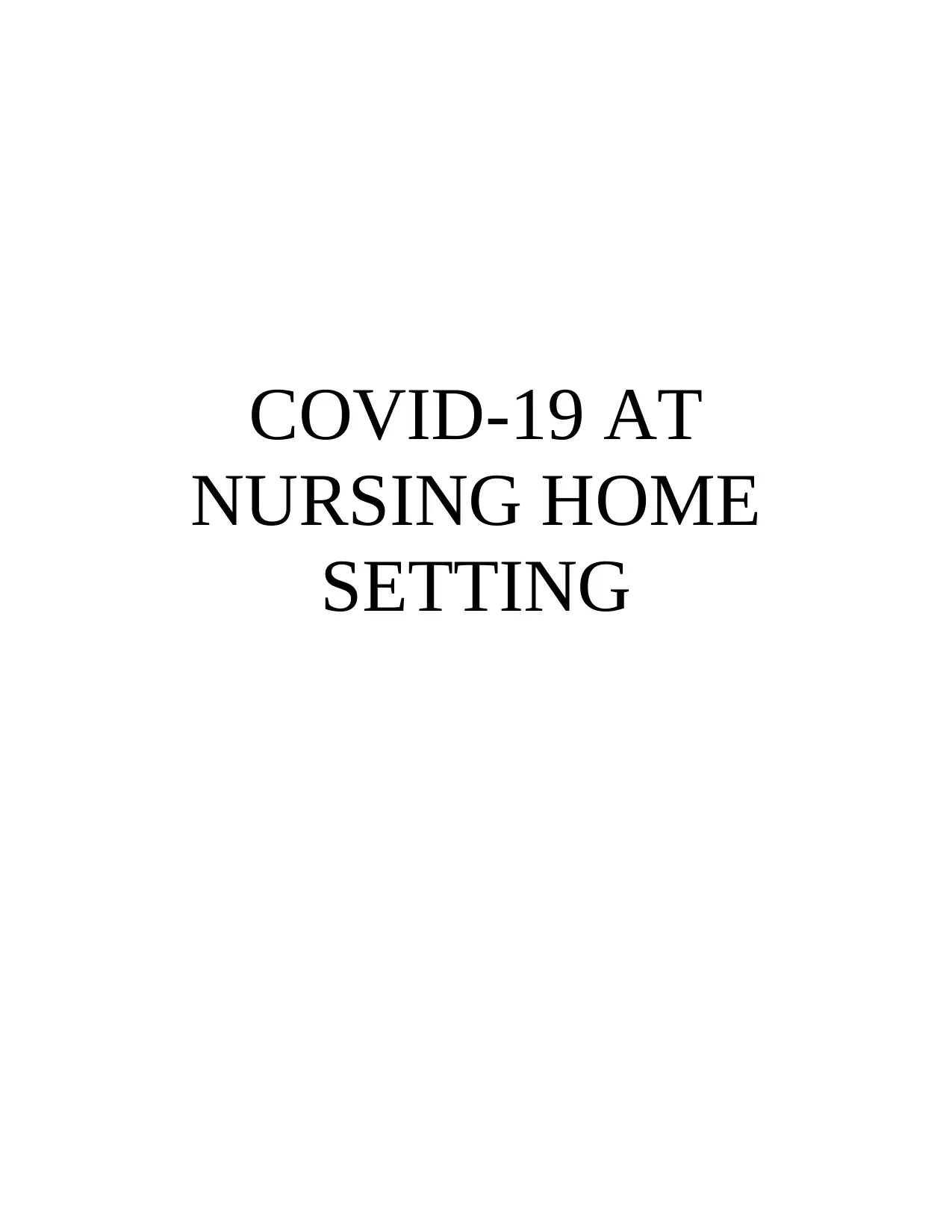
COVID-19 AT
NURSING HOME
SETTING
NURSING HOME
SETTING
Paraphrase This Document
Need a fresh take? Get an instant paraphrase of this document with our AI Paraphraser
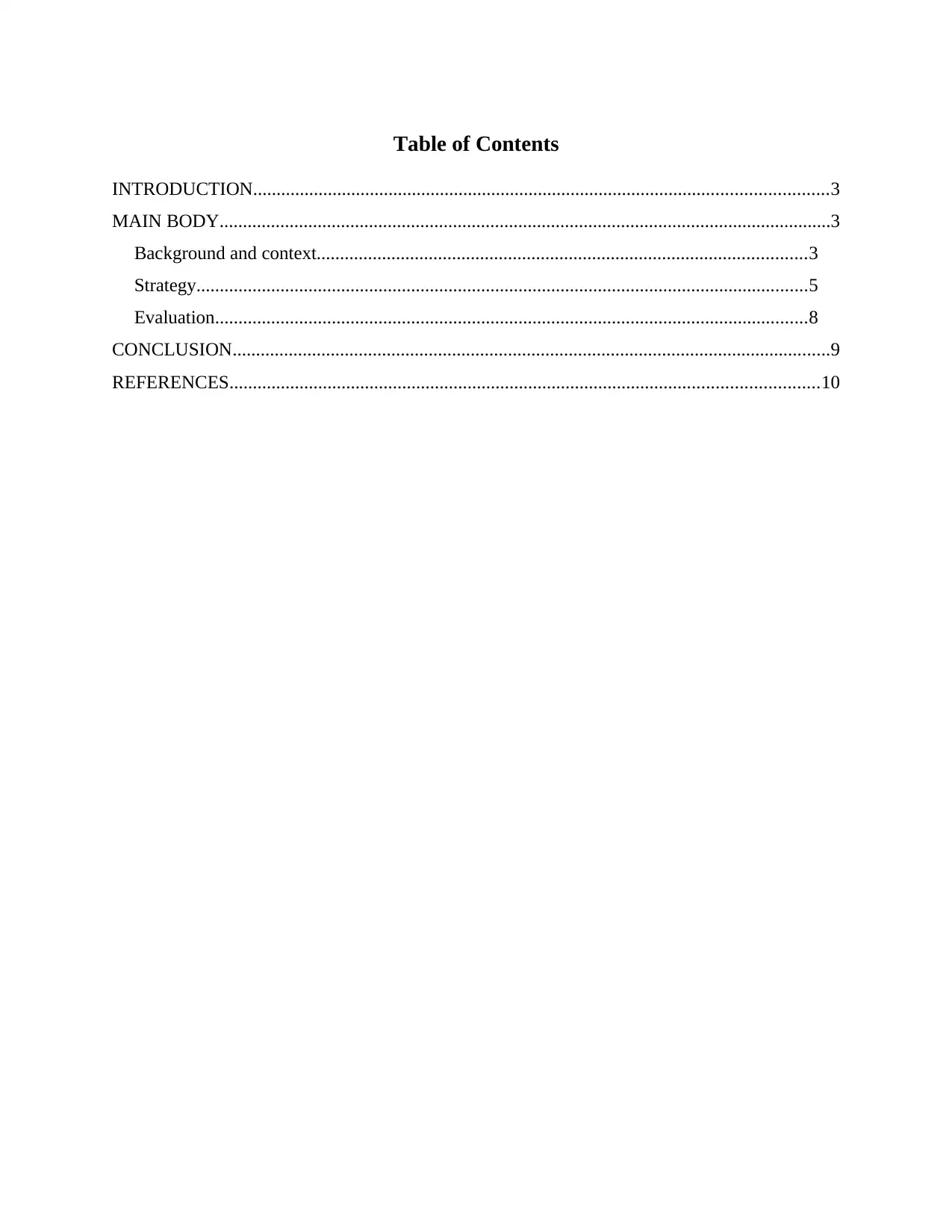
Table of Contents
INTRODUCTION...........................................................................................................................3
MAIN BODY...................................................................................................................................3
Background and context.........................................................................................................3
Strategy...................................................................................................................................5
Evaluation...............................................................................................................................8
CONCLUSION................................................................................................................................9
REFERENCES..............................................................................................................................10
INTRODUCTION...........................................................................................................................3
MAIN BODY...................................................................................................................................3
Background and context.........................................................................................................3
Strategy...................................................................................................................................5
Evaluation...............................................................................................................................8
CONCLUSION................................................................................................................................9
REFERENCES..............................................................................................................................10
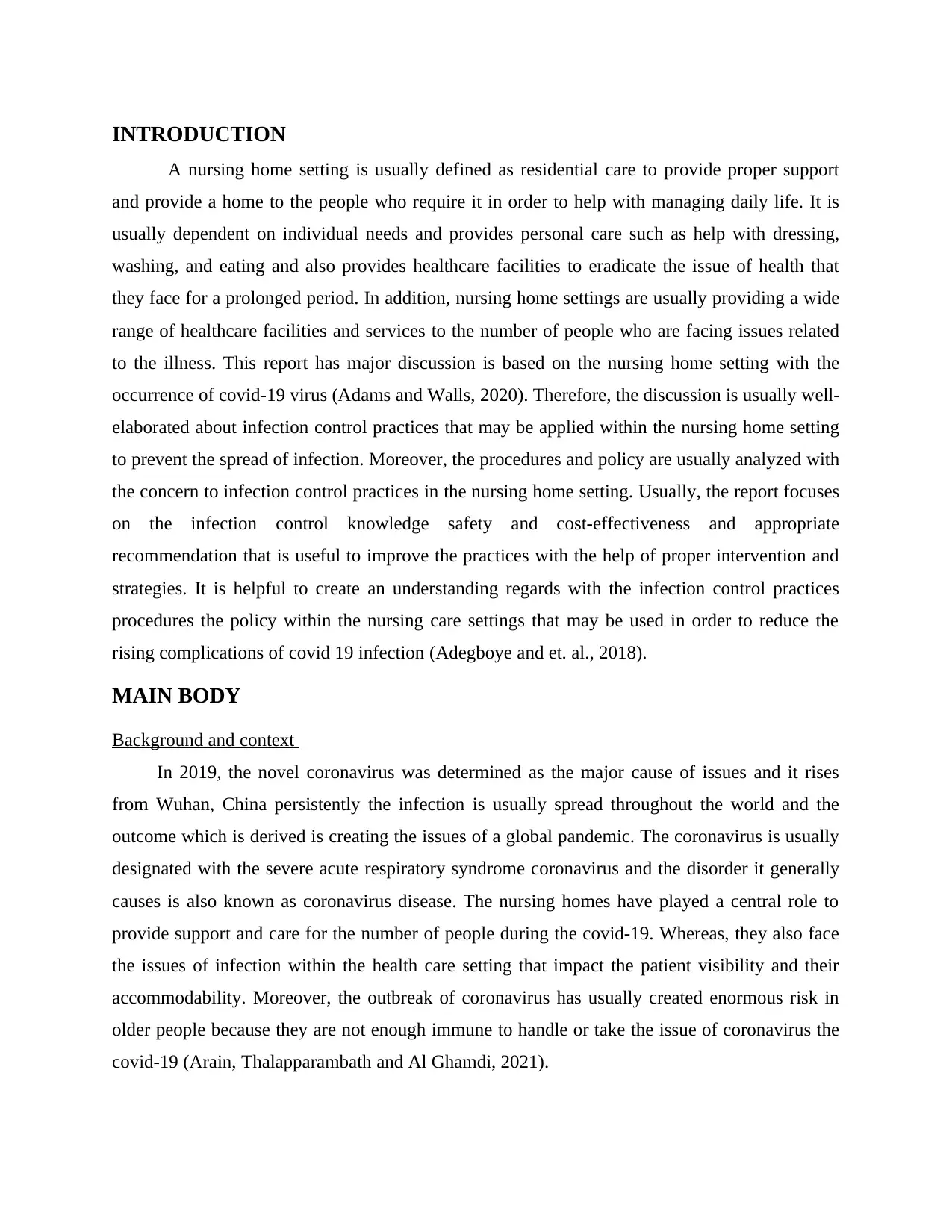
INTRODUCTION
A nursing home setting is usually defined as residential care to provide proper support
and provide a home to the people who require it in order to help with managing daily life. It is
usually dependent on individual needs and provides personal care such as help with dressing,
washing, and eating and also provides healthcare facilities to eradicate the issue of health that
they face for a prolonged period. In addition, nursing home settings are usually providing a wide
range of healthcare facilities and services to the number of people who are facing issues related
to the illness. This report has major discussion is based on the nursing home setting with the
occurrence of covid-19 virus (Adams and Walls, 2020). Therefore, the discussion is usually well-
elaborated about infection control practices that may be applied within the nursing home setting
to prevent the spread of infection. Moreover, the procedures and policy are usually analyzed with
the concern to infection control practices in the nursing home setting. Usually, the report focuses
on the infection control knowledge safety and cost-effectiveness and appropriate
recommendation that is useful to improve the practices with the help of proper intervention and
strategies. It is helpful to create an understanding regards with the infection control practices
procedures the policy within the nursing care settings that may be used in order to reduce the
rising complications of covid 19 infection (Adegboye and et. al., 2018).
MAIN BODY
Background and context
In 2019, the novel coronavirus was determined as the major cause of issues and it rises
from Wuhan, China persistently the infection is usually spread throughout the world and the
outcome which is derived is creating the issues of a global pandemic. The coronavirus is usually
designated with the severe acute respiratory syndrome coronavirus and the disorder it generally
causes is also known as coronavirus disease. The nursing homes have played a central role to
provide support and care for the number of people during the covid-19. Whereas, they also face
the issues of infection within the health care setting that impact the patient visibility and their
accommodability. Moreover, the outbreak of coronavirus has usually created enormous risk in
older people because they are not enough immune to handle or take the issue of coronavirus the
covid-19 (Arain, Thalapparambath and Al Ghamdi, 2021).
A nursing home setting is usually defined as residential care to provide proper support
and provide a home to the people who require it in order to help with managing daily life. It is
usually dependent on individual needs and provides personal care such as help with dressing,
washing, and eating and also provides healthcare facilities to eradicate the issue of health that
they face for a prolonged period. In addition, nursing home settings are usually providing a wide
range of healthcare facilities and services to the number of people who are facing issues related
to the illness. This report has major discussion is based on the nursing home setting with the
occurrence of covid-19 virus (Adams and Walls, 2020). Therefore, the discussion is usually well-
elaborated about infection control practices that may be applied within the nursing home setting
to prevent the spread of infection. Moreover, the procedures and policy are usually analyzed with
the concern to infection control practices in the nursing home setting. Usually, the report focuses
on the infection control knowledge safety and cost-effectiveness and appropriate
recommendation that is useful to improve the practices with the help of proper intervention and
strategies. It is helpful to create an understanding regards with the infection control practices
procedures the policy within the nursing care settings that may be used in order to reduce the
rising complications of covid 19 infection (Adegboye and et. al., 2018).
MAIN BODY
Background and context
In 2019, the novel coronavirus was determined as the major cause of issues and it rises
from Wuhan, China persistently the infection is usually spread throughout the world and the
outcome which is derived is creating the issues of a global pandemic. The coronavirus is usually
designated with the severe acute respiratory syndrome coronavirus and the disorder it generally
causes is also known as coronavirus disease. The nursing homes have played a central role to
provide support and care for the number of people during the covid-19. Whereas, they also face
the issues of infection within the health care setting that impact the patient visibility and their
accommodability. Moreover, the outbreak of coronavirus has usually created enormous risk in
older people because they are not enough immune to handle or take the issue of coronavirus the
covid-19 (Arain, Thalapparambath and Al Ghamdi, 2021).
⊘ This is a preview!⊘
Do you want full access?
Subscribe today to unlock all pages.

Trusted by 1+ million students worldwide
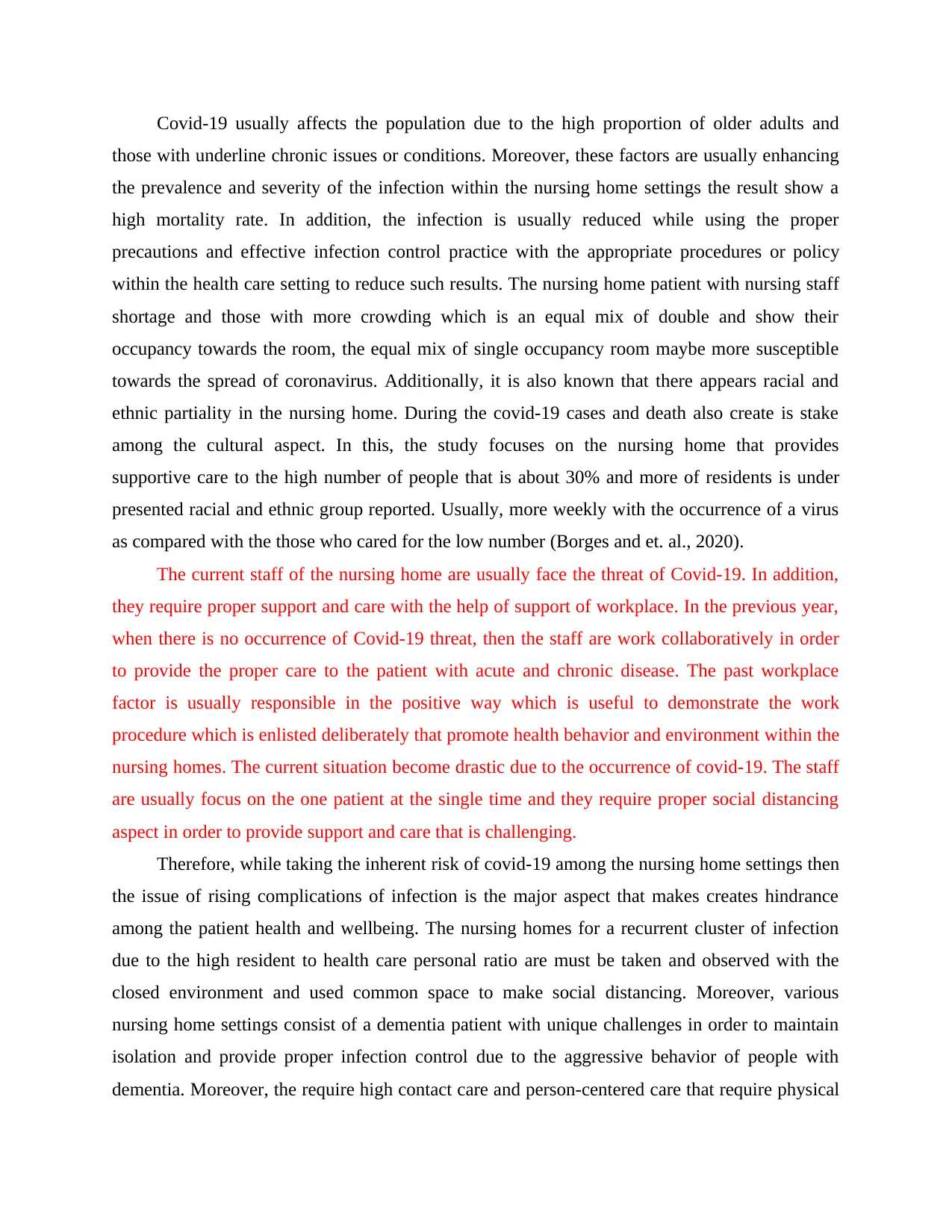
Covid-19 usually affects the population due to the high proportion of older adults and
those with underline chronic issues or conditions. Moreover, these factors are usually enhancing
the prevalence and severity of the infection within the nursing home settings the result show a
high mortality rate. In addition, the infection is usually reduced while using the proper
precautions and effective infection control practice with the appropriate procedures or policy
within the health care setting to reduce such results. The nursing home patient with nursing staff
shortage and those with more crowding which is an equal mix of double and show their
occupancy towards the room, the equal mix of single occupancy room maybe more susceptible
towards the spread of coronavirus. Additionally, it is also known that there appears racial and
ethnic partiality in the nursing home. During the covid-19 cases and death also create is stake
among the cultural aspect. In this, the study focuses on the nursing home that provides
supportive care to the high number of people that is about 30% and more of residents is under
presented racial and ethnic group reported. Usually, more weekly with the occurrence of a virus
as compared with the those who cared for the low number (Borges and et. al., 2020).
The current staff of the nursing home are usually face the threat of Covid-19. In addition,
they require proper support and care with the help of support of workplace. In the previous year,
when there is no occurrence of Covid-19 threat, then the staff are work collaboratively in order
to provide the proper care to the patient with acute and chronic disease. The past workplace
factor is usually responsible in the positive way which is useful to demonstrate the work
procedure which is enlisted deliberately that promote health behavior and environment within the
nursing homes. The current situation become drastic due to the occurrence of covid-19. The staff
are usually focus on the one patient at the single time and they require proper social distancing
aspect in order to provide support and care that is challenging.
Therefore, while taking the inherent risk of covid-19 among the nursing home settings then
the issue of rising complications of infection is the major aspect that makes creates hindrance
among the patient health and wellbeing. The nursing homes for a recurrent cluster of infection
due to the high resident to health care personal ratio are must be taken and observed with the
closed environment and used common space to make social distancing. Moreover, various
nursing home settings consist of a dementia patient with unique challenges in order to maintain
isolation and provide proper infection control due to the aggressive behavior of people with
dementia. Moreover, the require high contact care and person-centered care that require physical
those with underline chronic issues or conditions. Moreover, these factors are usually enhancing
the prevalence and severity of the infection within the nursing home settings the result show a
high mortality rate. In addition, the infection is usually reduced while using the proper
precautions and effective infection control practice with the appropriate procedures or policy
within the health care setting to reduce such results. The nursing home patient with nursing staff
shortage and those with more crowding which is an equal mix of double and show their
occupancy towards the room, the equal mix of single occupancy room maybe more susceptible
towards the spread of coronavirus. Additionally, it is also known that there appears racial and
ethnic partiality in the nursing home. During the covid-19 cases and death also create is stake
among the cultural aspect. In this, the study focuses on the nursing home that provides
supportive care to the high number of people that is about 30% and more of residents is under
presented racial and ethnic group reported. Usually, more weekly with the occurrence of a virus
as compared with the those who cared for the low number (Borges and et. al., 2020).
The current staff of the nursing home are usually face the threat of Covid-19. In addition,
they require proper support and care with the help of support of workplace. In the previous year,
when there is no occurrence of Covid-19 threat, then the staff are work collaboratively in order
to provide the proper care to the patient with acute and chronic disease. The past workplace
factor is usually responsible in the positive way which is useful to demonstrate the work
procedure which is enlisted deliberately that promote health behavior and environment within the
nursing homes. The current situation become drastic due to the occurrence of covid-19. The staff
are usually focus on the one patient at the single time and they require proper social distancing
aspect in order to provide support and care that is challenging.
Therefore, while taking the inherent risk of covid-19 among the nursing home settings then
the issue of rising complications of infection is the major aspect that makes creates hindrance
among the patient health and wellbeing. The nursing homes for a recurrent cluster of infection
due to the high resident to health care personal ratio are must be taken and observed with the
closed environment and used common space to make social distancing. Moreover, various
nursing home settings consist of a dementia patient with unique challenges in order to maintain
isolation and provide proper infection control due to the aggressive behavior of people with
dementia. Moreover, the require high contact care and person-centered care that require physical
Paraphrase This Document
Need a fresh take? Get an instant paraphrase of this document with our AI Paraphraser
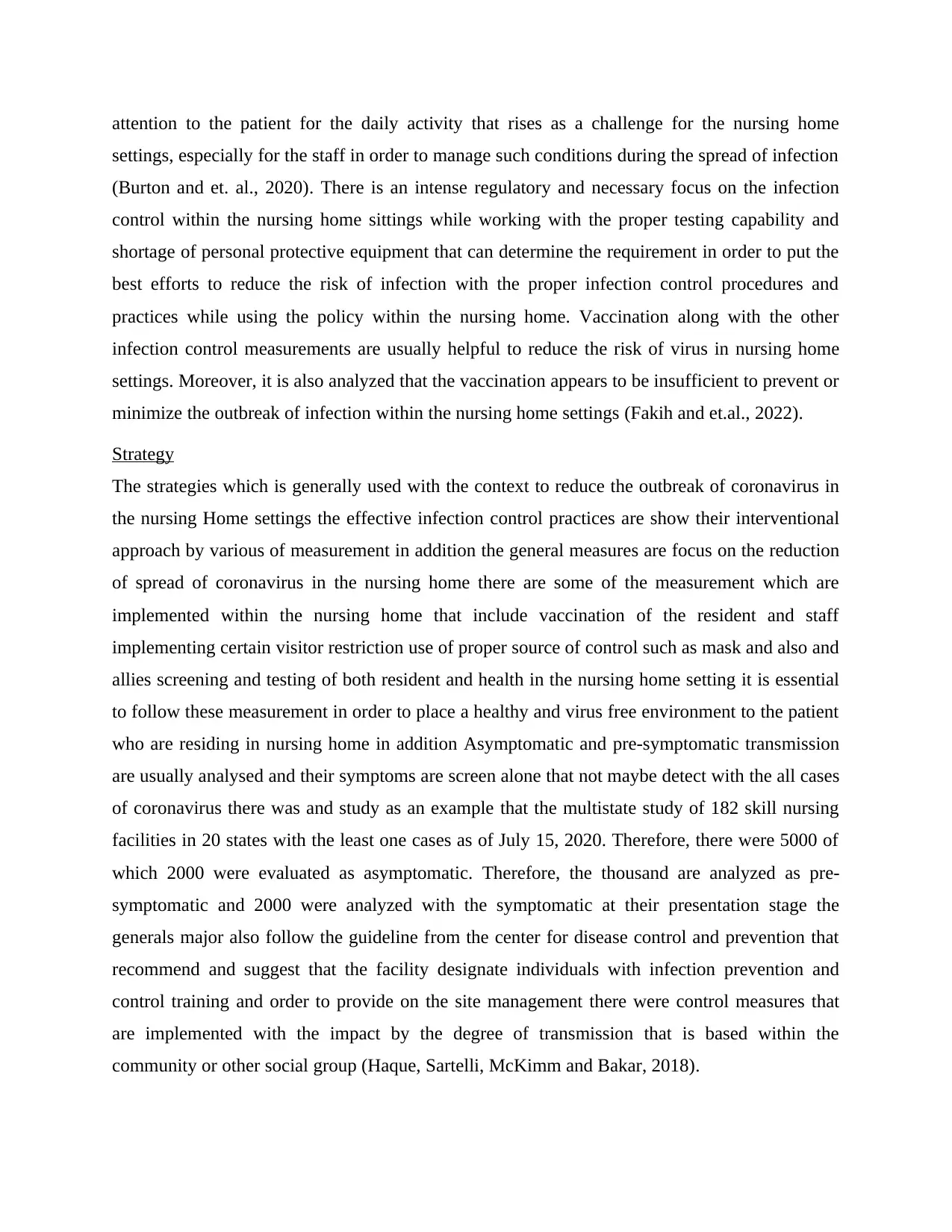
attention to the patient for the daily activity that rises as a challenge for the nursing home
settings, especially for the staff in order to manage such conditions during the spread of infection
(Burton and et. al., 2020). There is an intense regulatory and necessary focus on the infection
control within the nursing home sittings while working with the proper testing capability and
shortage of personal protective equipment that can determine the requirement in order to put the
best efforts to reduce the risk of infection with the proper infection control procedures and
practices while using the policy within the nursing home. Vaccination along with the other
infection control measurements are usually helpful to reduce the risk of virus in nursing home
settings. Moreover, it is also analyzed that the vaccination appears to be insufficient to prevent or
minimize the outbreak of infection within the nursing home settings (Fakih and et.al., 2022).
Strategy
The strategies which is generally used with the context to reduce the outbreak of coronavirus in
the nursing Home settings the effective infection control practices are show their interventional
approach by various of measurement in addition the general measures are focus on the reduction
of spread of coronavirus in the nursing home there are some of the measurement which are
implemented within the nursing home that include vaccination of the resident and staff
implementing certain visitor restriction use of proper source of control such as mask and also and
allies screening and testing of both resident and health in the nursing home setting it is essential
to follow these measurement in order to place a healthy and virus free environment to the patient
who are residing in nursing home in addition Asymptomatic and pre-symptomatic transmission
are usually analysed and their symptoms are screen alone that not maybe detect with the all cases
of coronavirus there was and study as an example that the multistate study of 182 skill nursing
facilities in 20 states with the least one cases as of July 15, 2020. Therefore, there were 5000 of
which 2000 were evaluated as asymptomatic. Therefore, the thousand are analyzed as pre-
symptomatic and 2000 were analyzed with the symptomatic at their presentation stage the
generals major also follow the guideline from the center for disease control and prevention that
recommend and suggest that the facility designate individuals with infection prevention and
control training and order to provide on the site management there were control measures that
are implemented with the impact by the degree of transmission that is based within the
community or other social group (Haque, Sartelli, McKimm and Bakar, 2018).
settings, especially for the staff in order to manage such conditions during the spread of infection
(Burton and et. al., 2020). There is an intense regulatory and necessary focus on the infection
control within the nursing home sittings while working with the proper testing capability and
shortage of personal protective equipment that can determine the requirement in order to put the
best efforts to reduce the risk of infection with the proper infection control procedures and
practices while using the policy within the nursing home. Vaccination along with the other
infection control measurements are usually helpful to reduce the risk of virus in nursing home
settings. Moreover, it is also analyzed that the vaccination appears to be insufficient to prevent or
minimize the outbreak of infection within the nursing home settings (Fakih and et.al., 2022).
Strategy
The strategies which is generally used with the context to reduce the outbreak of coronavirus in
the nursing Home settings the effective infection control practices are show their interventional
approach by various of measurement in addition the general measures are focus on the reduction
of spread of coronavirus in the nursing home there are some of the measurement which are
implemented within the nursing home that include vaccination of the resident and staff
implementing certain visitor restriction use of proper source of control such as mask and also and
allies screening and testing of both resident and health in the nursing home setting it is essential
to follow these measurement in order to place a healthy and virus free environment to the patient
who are residing in nursing home in addition Asymptomatic and pre-symptomatic transmission
are usually analysed and their symptoms are screen alone that not maybe detect with the all cases
of coronavirus there was and study as an example that the multistate study of 182 skill nursing
facilities in 20 states with the least one cases as of July 15, 2020. Therefore, there were 5000 of
which 2000 were evaluated as asymptomatic. Therefore, the thousand are analyzed as pre-
symptomatic and 2000 were analyzed with the symptomatic at their presentation stage the
generals major also follow the guideline from the center for disease control and prevention that
recommend and suggest that the facility designate individuals with infection prevention and
control training and order to provide on the site management there were control measures that
are implemented with the impact by the degree of transmission that is based within the
community or other social group (Haque, Sartelli, McKimm and Bakar, 2018).
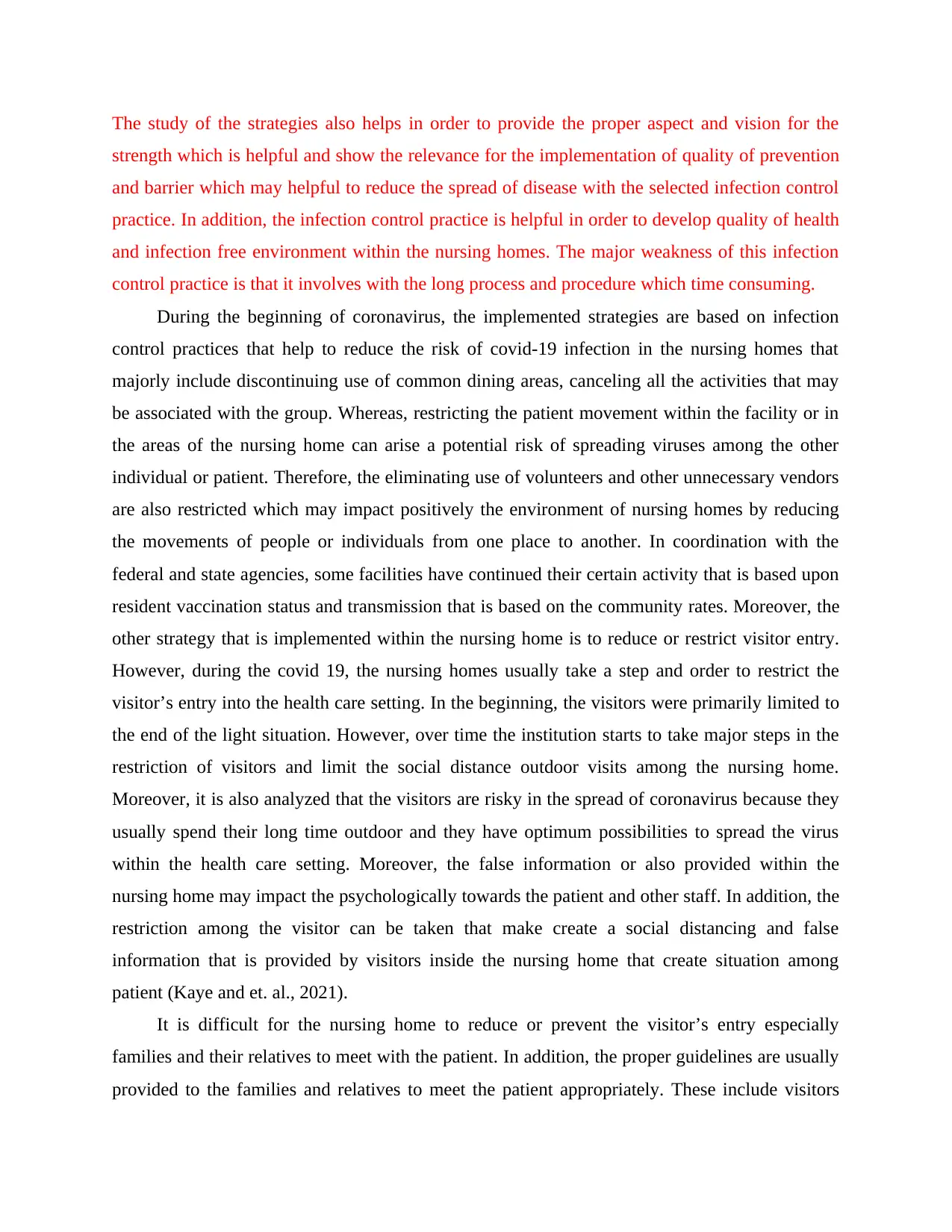
The study of the strategies also helps in order to provide the proper aspect and vision for the
strength which is helpful and show the relevance for the implementation of quality of prevention
and barrier which may helpful to reduce the spread of disease with the selected infection control
practice. In addition, the infection control practice is helpful in order to develop quality of health
and infection free environment within the nursing homes. The major weakness of this infection
control practice is that it involves with the long process and procedure which time consuming.
During the beginning of coronavirus, the implemented strategies are based on infection
control practices that help to reduce the risk of covid-19 infection in the nursing homes that
majorly include discontinuing use of common dining areas, canceling all the activities that may
be associated with the group. Whereas, restricting the patient movement within the facility or in
the areas of the nursing home can arise a potential risk of spreading viruses among the other
individual or patient. Therefore, the eliminating use of volunteers and other unnecessary vendors
are also restricted which may impact positively the environment of nursing homes by reducing
the movements of people or individuals from one place to another. In coordination with the
federal and state agencies, some facilities have continued their certain activity that is based upon
resident vaccination status and transmission that is based on the community rates. Moreover, the
other strategy that is implemented within the nursing home is to reduce or restrict visitor entry.
However, during the covid 19, the nursing homes usually take a step and order to restrict the
visitor’s entry into the health care setting. In the beginning, the visitors were primarily limited to
the end of the light situation. However, over time the institution starts to take major steps in the
restriction of visitors and limit the social distance outdoor visits among the nursing home.
Moreover, it is also analyzed that the visitors are risky in the spread of coronavirus because they
usually spend their long time outdoor and they have optimum possibilities to spread the virus
within the health care setting. Moreover, the false information or also provided within the
nursing home may impact the psychologically towards the patient and other staff. In addition, the
restriction among the visitor can be taken that make create a social distancing and false
information that is provided by visitors inside the nursing home that create situation among
patient (Kaye and et. al., 2021).
It is difficult for the nursing home to reduce or prevent the visitor’s entry especially
families and their relatives to meet with the patient. In addition, the proper guidelines are usually
provided to the families and relatives to meet the patient appropriately. These include visitors
strength which is helpful and show the relevance for the implementation of quality of prevention
and barrier which may helpful to reduce the spread of disease with the selected infection control
practice. In addition, the infection control practice is helpful in order to develop quality of health
and infection free environment within the nursing homes. The major weakness of this infection
control practice is that it involves with the long process and procedure which time consuming.
During the beginning of coronavirus, the implemented strategies are based on infection
control practices that help to reduce the risk of covid-19 infection in the nursing homes that
majorly include discontinuing use of common dining areas, canceling all the activities that may
be associated with the group. Whereas, restricting the patient movement within the facility or in
the areas of the nursing home can arise a potential risk of spreading viruses among the other
individual or patient. Therefore, the eliminating use of volunteers and other unnecessary vendors
are also restricted which may impact positively the environment of nursing homes by reducing
the movements of people or individuals from one place to another. In coordination with the
federal and state agencies, some facilities have continued their certain activity that is based upon
resident vaccination status and transmission that is based on the community rates. Moreover, the
other strategy that is implemented within the nursing home is to reduce or restrict visitor entry.
However, during the covid 19, the nursing homes usually take a step and order to restrict the
visitor’s entry into the health care setting. In the beginning, the visitors were primarily limited to
the end of the light situation. However, over time the institution starts to take major steps in the
restriction of visitors and limit the social distance outdoor visits among the nursing home.
Moreover, it is also analyzed that the visitors are risky in the spread of coronavirus because they
usually spend their long time outdoor and they have optimum possibilities to spread the virus
within the health care setting. Moreover, the false information or also provided within the
nursing home may impact the psychologically towards the patient and other staff. In addition, the
restriction among the visitor can be taken that make create a social distancing and false
information that is provided by visitors inside the nursing home that create situation among
patient (Kaye and et. al., 2021).
It is difficult for the nursing home to reduce or prevent the visitor’s entry especially
families and their relatives to meet with the patient. In addition, the proper guidelines are usually
provided to the families and relatives to meet the patient appropriately. These include visitors
⊘ This is a preview!⊘
Do you want full access?
Subscribe today to unlock all pages.

Trusted by 1+ million students worldwide
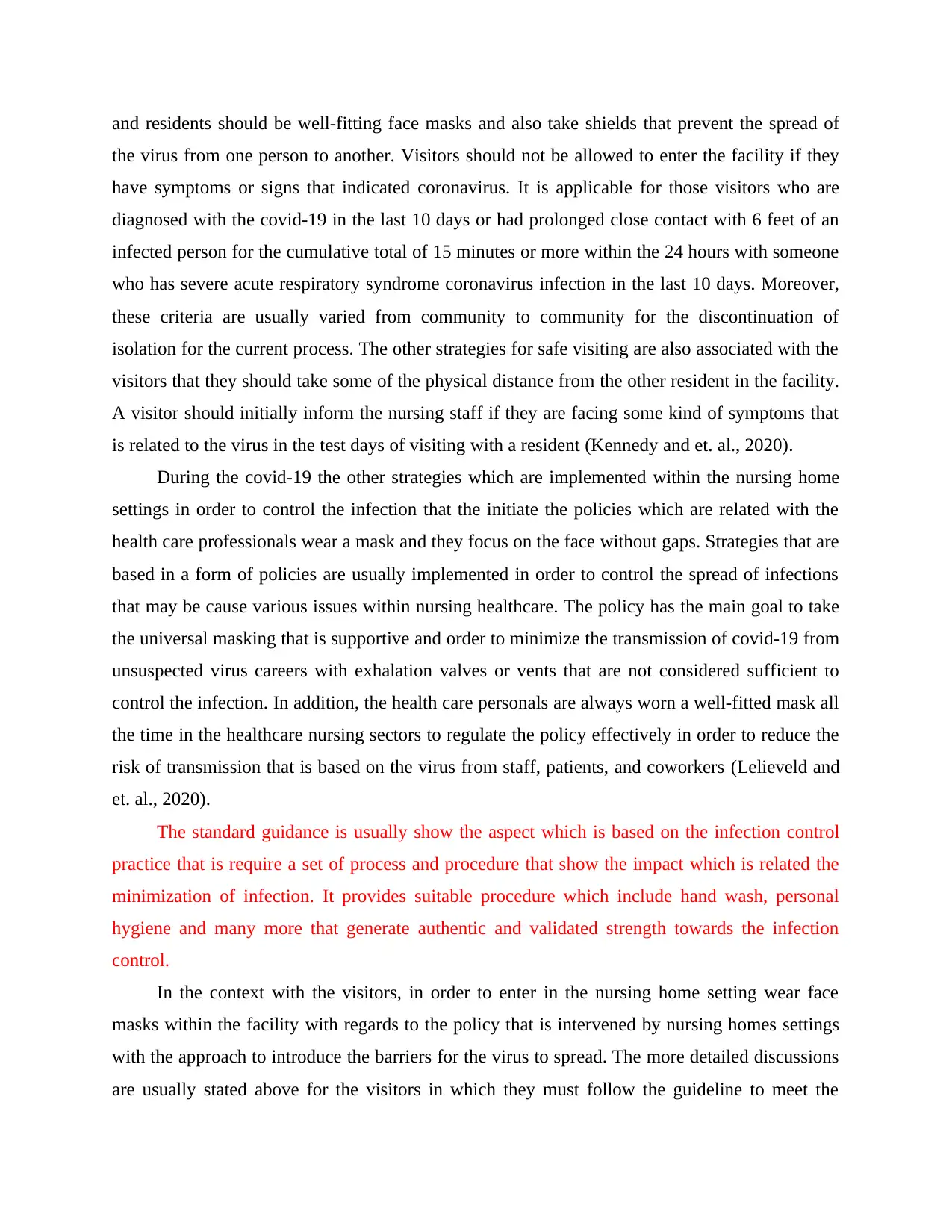
and residents should be well-fitting face masks and also take shields that prevent the spread of
the virus from one person to another. Visitors should not be allowed to enter the facility if they
have symptoms or signs that indicated coronavirus. It is applicable for those visitors who are
diagnosed with the covid-19 in the last 10 days or had prolonged close contact with 6 feet of an
infected person for the cumulative total of 15 minutes or more within the 24 hours with someone
who has severe acute respiratory syndrome coronavirus infection in the last 10 days. Moreover,
these criteria are usually varied from community to community for the discontinuation of
isolation for the current process. The other strategies for safe visiting are also associated with the
visitors that they should take some of the physical distance from the other resident in the facility.
A visitor should initially inform the nursing staff if they are facing some kind of symptoms that
is related to the virus in the test days of visiting with a resident (Kennedy and et. al., 2020).
During the covid-19 the other strategies which are implemented within the nursing home
settings in order to control the infection that the initiate the policies which are related with the
health care professionals wear a mask and they focus on the face without gaps. Strategies that are
based in a form of policies are usually implemented in order to control the spread of infections
that may be cause various issues within nursing healthcare. The policy has the main goal to take
the universal masking that is supportive and order to minimize the transmission of covid-19 from
unsuspected virus careers with exhalation valves or vents that are not considered sufficient to
control the infection. In addition, the health care personals are always worn a well-fitted mask all
the time in the healthcare nursing sectors to regulate the policy effectively in order to reduce the
risk of transmission that is based on the virus from staff, patients, and coworkers (Lelieveld and
et. al., 2020).
The standard guidance is usually show the aspect which is based on the infection control
practice that is require a set of process and procedure that show the impact which is related the
minimization of infection. It provides suitable procedure which include hand wash, personal
hygiene and many more that generate authentic and validated strength towards the infection
control.
In the context with the visitors, in order to enter in the nursing home setting wear face
masks within the facility with regards to the policy that is intervened by nursing homes settings
with the approach to introduce the barriers for the virus to spread. The more detailed discussions
are usually stated above for the visitors in which they must follow the guideline to meet the
the virus from one person to another. Visitors should not be allowed to enter the facility if they
have symptoms or signs that indicated coronavirus. It is applicable for those visitors who are
diagnosed with the covid-19 in the last 10 days or had prolonged close contact with 6 feet of an
infected person for the cumulative total of 15 minutes or more within the 24 hours with someone
who has severe acute respiratory syndrome coronavirus infection in the last 10 days. Moreover,
these criteria are usually varied from community to community for the discontinuation of
isolation for the current process. The other strategies for safe visiting are also associated with the
visitors that they should take some of the physical distance from the other resident in the facility.
A visitor should initially inform the nursing staff if they are facing some kind of symptoms that
is related to the virus in the test days of visiting with a resident (Kennedy and et. al., 2020).
During the covid-19 the other strategies which are implemented within the nursing home
settings in order to control the infection that the initiate the policies which are related with the
health care professionals wear a mask and they focus on the face without gaps. Strategies that are
based in a form of policies are usually implemented in order to control the spread of infections
that may be cause various issues within nursing healthcare. The policy has the main goal to take
the universal masking that is supportive and order to minimize the transmission of covid-19 from
unsuspected virus careers with exhalation valves or vents that are not considered sufficient to
control the infection. In addition, the health care personals are always worn a well-fitted mask all
the time in the healthcare nursing sectors to regulate the policy effectively in order to reduce the
risk of transmission that is based on the virus from staff, patients, and coworkers (Lelieveld and
et. al., 2020).
The standard guidance is usually show the aspect which is based on the infection control
practice that is require a set of process and procedure that show the impact which is related the
minimization of infection. It provides suitable procedure which include hand wash, personal
hygiene and many more that generate authentic and validated strength towards the infection
control.
In the context with the visitors, in order to enter in the nursing home setting wear face
masks within the facility with regards to the policy that is intervened by nursing homes settings
with the approach to introduce the barriers for the virus to spread. The more detailed discussions
are usually stated above for the visitors in which they must follow the guideline to meet the
Paraphrase This Document
Need a fresh take? Get an instant paraphrase of this document with our AI Paraphraser
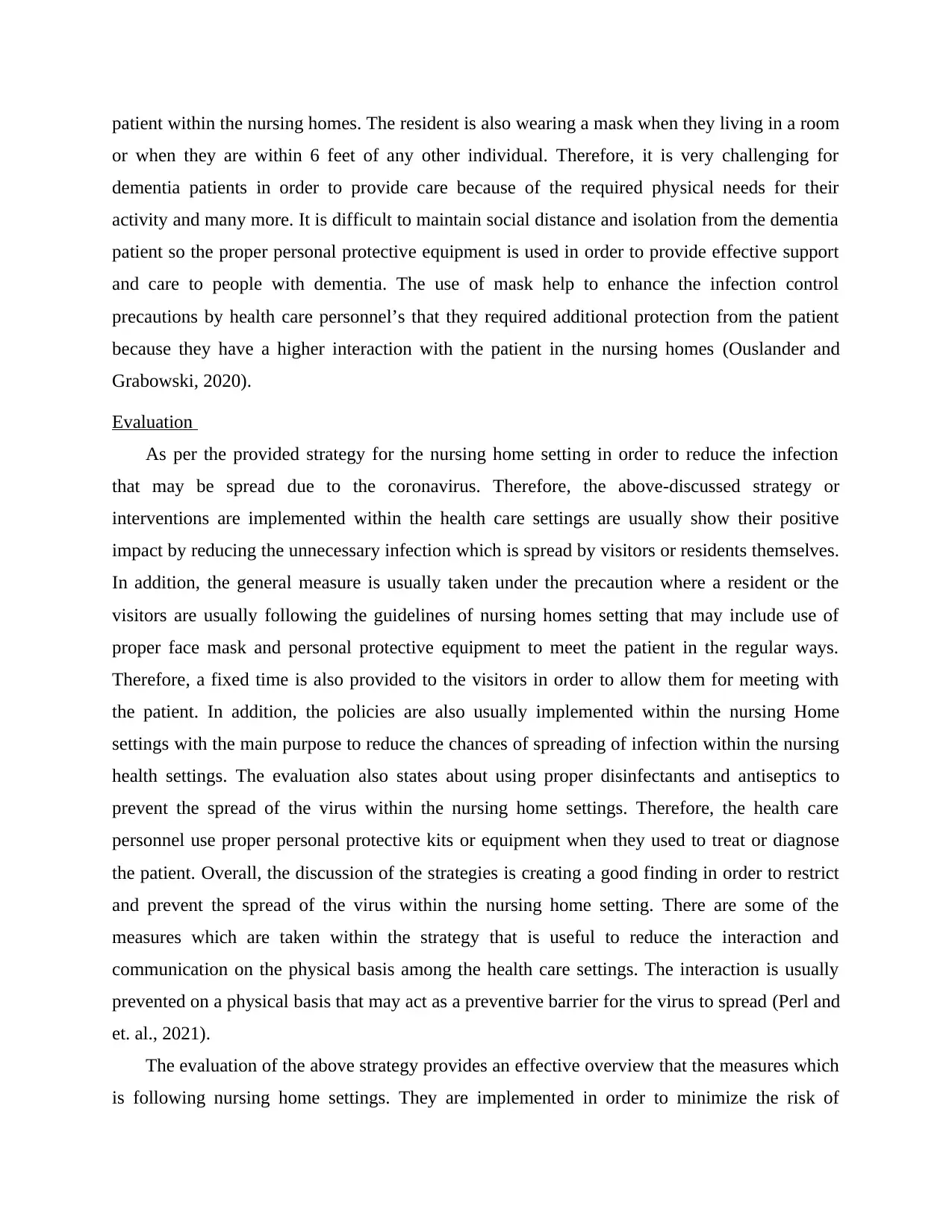
patient within the nursing homes. The resident is also wearing a mask when they living in a room
or when they are within 6 feet of any other individual. Therefore, it is very challenging for
dementia patients in order to provide care because of the required physical needs for their
activity and many more. It is difficult to maintain social distance and isolation from the dementia
patient so the proper personal protective equipment is used in order to provide effective support
and care to people with dementia. The use of mask help to enhance the infection control
precautions by health care personnel’s that they required additional protection from the patient
because they have a higher interaction with the patient in the nursing homes (Ouslander and
Grabowski, 2020).
Evaluation
As per the provided strategy for the nursing home setting in order to reduce the infection
that may be spread due to the coronavirus. Therefore, the above-discussed strategy or
interventions are implemented within the health care settings are usually show their positive
impact by reducing the unnecessary infection which is spread by visitors or residents themselves.
In addition, the general measure is usually taken under the precaution where a resident or the
visitors are usually following the guidelines of nursing homes setting that may include use of
proper face mask and personal protective equipment to meet the patient in the regular ways.
Therefore, a fixed time is also provided to the visitors in order to allow them for meeting with
the patient. In addition, the policies are also usually implemented within the nursing Home
settings with the main purpose to reduce the chances of spreading of infection within the nursing
health settings. The evaluation also states about using proper disinfectants and antiseptics to
prevent the spread of the virus within the nursing home settings. Therefore, the health care
personnel use proper personal protective kits or equipment when they used to treat or diagnose
the patient. Overall, the discussion of the strategies is creating a good finding in order to restrict
and prevent the spread of the virus within the nursing home setting. There are some of the
measures which are taken within the strategy that is useful to reduce the interaction and
communication on the physical basis among the health care settings. The interaction is usually
prevented on a physical basis that may act as a preventive barrier for the virus to spread (Perl and
et. al., 2021).
The evaluation of the above strategy provides an effective overview that the measures which
is following nursing home settings. They are implemented in order to minimize the risk of
or when they are within 6 feet of any other individual. Therefore, it is very challenging for
dementia patients in order to provide care because of the required physical needs for their
activity and many more. It is difficult to maintain social distance and isolation from the dementia
patient so the proper personal protective equipment is used in order to provide effective support
and care to people with dementia. The use of mask help to enhance the infection control
precautions by health care personnel’s that they required additional protection from the patient
because they have a higher interaction with the patient in the nursing homes (Ouslander and
Grabowski, 2020).
Evaluation
As per the provided strategy for the nursing home setting in order to reduce the infection
that may be spread due to the coronavirus. Therefore, the above-discussed strategy or
interventions are implemented within the health care settings are usually show their positive
impact by reducing the unnecessary infection which is spread by visitors or residents themselves.
In addition, the general measure is usually taken under the precaution where a resident or the
visitors are usually following the guidelines of nursing homes setting that may include use of
proper face mask and personal protective equipment to meet the patient in the regular ways.
Therefore, a fixed time is also provided to the visitors in order to allow them for meeting with
the patient. In addition, the policies are also usually implemented within the nursing Home
settings with the main purpose to reduce the chances of spreading of infection within the nursing
health settings. The evaluation also states about using proper disinfectants and antiseptics to
prevent the spread of the virus within the nursing home settings. Therefore, the health care
personnel use proper personal protective kits or equipment when they used to treat or diagnose
the patient. Overall, the discussion of the strategies is creating a good finding in order to restrict
and prevent the spread of the virus within the nursing home setting. There are some of the
measures which are taken within the strategy that is useful to reduce the interaction and
communication on the physical basis among the health care settings. The interaction is usually
prevented on a physical basis that may act as a preventive barrier for the virus to spread (Perl and
et. al., 2021).
The evaluation of the above strategy provides an effective overview that the measures which
is following nursing home settings. They are implemented in order to minimize the risk of
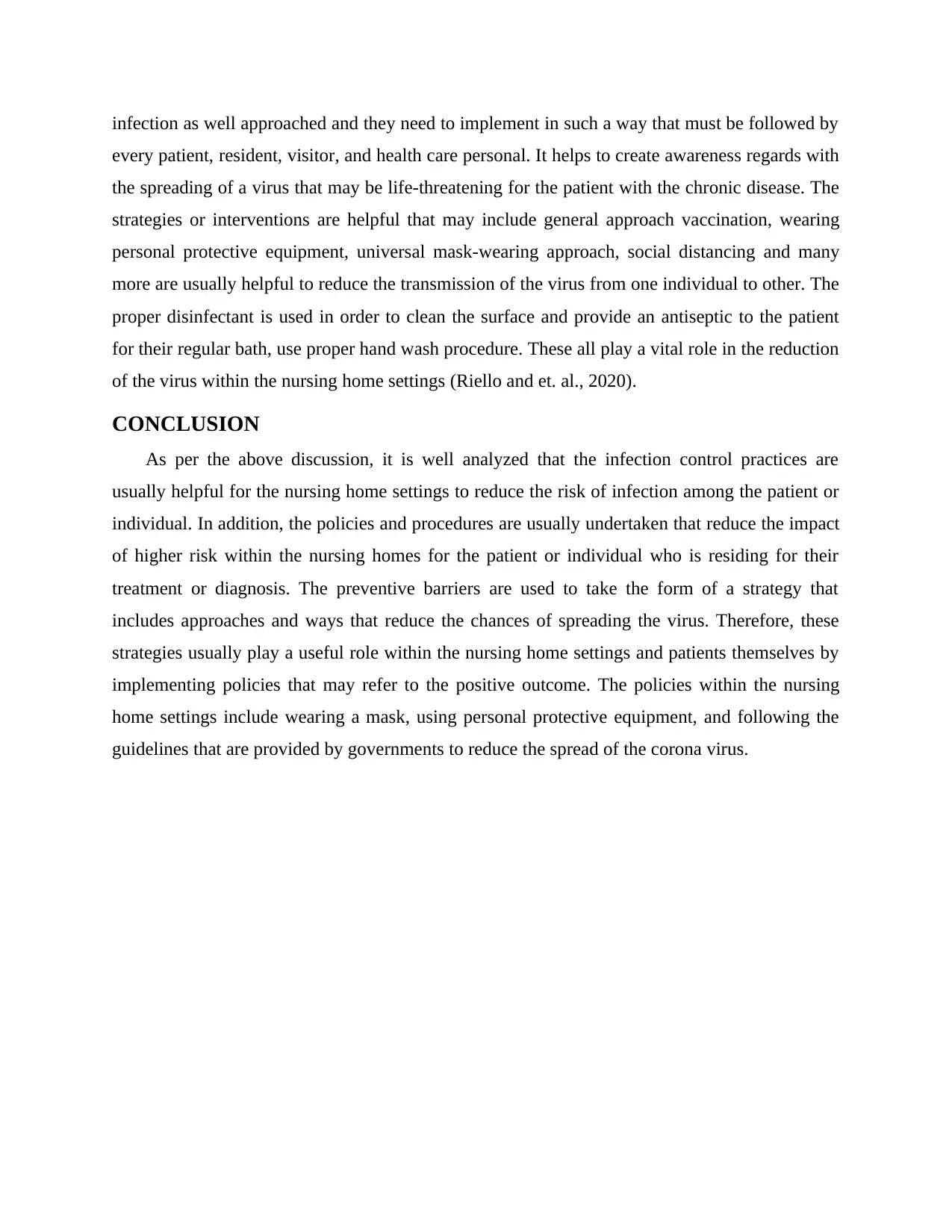
infection as well approached and they need to implement in such a way that must be followed by
every patient, resident, visitor, and health care personal. It helps to create awareness regards with
the spreading of a virus that may be life-threatening for the patient with the chronic disease. The
strategies or interventions are helpful that may include general approach vaccination, wearing
personal protective equipment, universal mask-wearing approach, social distancing and many
more are usually helpful to reduce the transmission of the virus from one individual to other. The
proper disinfectant is used in order to clean the surface and provide an antiseptic to the patient
for their regular bath, use proper hand wash procedure. These all play a vital role in the reduction
of the virus within the nursing home settings (Riello and et. al., 2020).
CONCLUSION
As per the above discussion, it is well analyzed that the infection control practices are
usually helpful for the nursing home settings to reduce the risk of infection among the patient or
individual. In addition, the policies and procedures are usually undertaken that reduce the impact
of higher risk within the nursing homes for the patient or individual who is residing for their
treatment or diagnosis. The preventive barriers are used to take the form of a strategy that
includes approaches and ways that reduce the chances of spreading the virus. Therefore, these
strategies usually play a useful role within the nursing home settings and patients themselves by
implementing policies that may refer to the positive outcome. The policies within the nursing
home settings include wearing a mask, using personal protective equipment, and following the
guidelines that are provided by governments to reduce the spread of the corona virus.
every patient, resident, visitor, and health care personal. It helps to create awareness regards with
the spreading of a virus that may be life-threatening for the patient with the chronic disease. The
strategies or interventions are helpful that may include general approach vaccination, wearing
personal protective equipment, universal mask-wearing approach, social distancing and many
more are usually helpful to reduce the transmission of the virus from one individual to other. The
proper disinfectant is used in order to clean the surface and provide an antiseptic to the patient
for their regular bath, use proper hand wash procedure. These all play a vital role in the reduction
of the virus within the nursing home settings (Riello and et. al., 2020).
CONCLUSION
As per the above discussion, it is well analyzed that the infection control practices are
usually helpful for the nursing home settings to reduce the risk of infection among the patient or
individual. In addition, the policies and procedures are usually undertaken that reduce the impact
of higher risk within the nursing homes for the patient or individual who is residing for their
treatment or diagnosis. The preventive barriers are used to take the form of a strategy that
includes approaches and ways that reduce the chances of spreading the virus. Therefore, these
strategies usually play a useful role within the nursing home settings and patients themselves by
implementing policies that may refer to the positive outcome. The policies within the nursing
home settings include wearing a mask, using personal protective equipment, and following the
guidelines that are provided by governments to reduce the spread of the corona virus.
⊘ This is a preview!⊘
Do you want full access?
Subscribe today to unlock all pages.

Trusted by 1+ million students worldwide
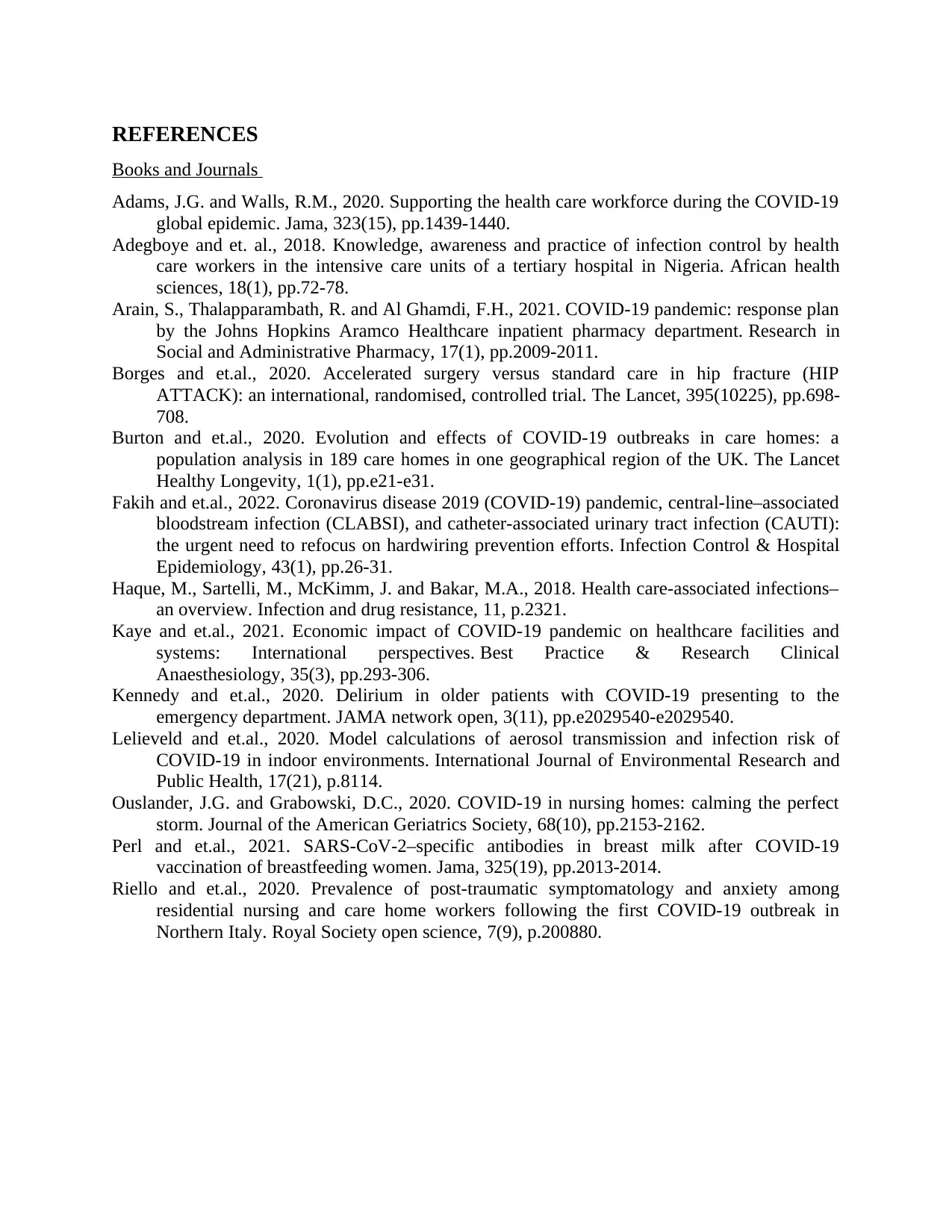
REFERENCES
Books and Journals
Adams, J.G. and Walls, R.M., 2020. Supporting the health care workforce during the COVID-19
global epidemic. Jama, 323(15), pp.1439-1440.
Adegboye and et. al., 2018. Knowledge, awareness and practice of infection control by health
care workers in the intensive care units of a tertiary hospital in Nigeria. African health
sciences, 18(1), pp.72-78.
Arain, S., Thalapparambath, R. and Al Ghamdi, F.H., 2021. COVID-19 pandemic: response plan
by the Johns Hopkins Aramco Healthcare inpatient pharmacy department. Research in
Social and Administrative Pharmacy, 17(1), pp.2009-2011.
Borges and et.al., 2020. Accelerated surgery versus standard care in hip fracture (HIP
ATTACK): an international, randomised, controlled trial. The Lancet, 395(10225), pp.698-
708.
Burton and et.al., 2020. Evolution and effects of COVID-19 outbreaks in care homes: a
population analysis in 189 care homes in one geographical region of the UK. The Lancet
Healthy Longevity, 1(1), pp.e21-e31.
Fakih and et.al., 2022. Coronavirus disease 2019 (COVID-19) pandemic, central-line–associated
bloodstream infection (CLABSI), and catheter-associated urinary tract infection (CAUTI):
the urgent need to refocus on hardwiring prevention efforts. Infection Control & Hospital
Epidemiology, 43(1), pp.26-31.
Haque, M., Sartelli, M., McKimm, J. and Bakar, M.A., 2018. Health care-associated infections–
an overview. Infection and drug resistance, 11, p.2321.
Kaye and et.al., 2021. Economic impact of COVID-19 pandemic on healthcare facilities and
systems: International perspectives. Best Practice & Research Clinical
Anaesthesiology, 35(3), pp.293-306.
Kennedy and et.al., 2020. Delirium in older patients with COVID-19 presenting to the
emergency department. JAMA network open, 3(11), pp.e2029540-e2029540.
Lelieveld and et.al., 2020. Model calculations of aerosol transmission and infection risk of
COVID-19 in indoor environments. International Journal of Environmental Research and
Public Health, 17(21), p.8114.
Ouslander, J.G. and Grabowski, D.C., 2020. COVID‐19 in nursing homes: calming the perfect
storm. Journal of the American Geriatrics Society, 68(10), pp.2153-2162.
Perl and et.al., 2021. SARS-CoV-2–specific antibodies in breast milk after COVID-19
vaccination of breastfeeding women. Jama, 325(19), pp.2013-2014.
Riello and et.al., 2020. Prevalence of post-traumatic symptomatology and anxiety among
residential nursing and care home workers following the first COVID-19 outbreak in
Northern Italy. Royal Society open science, 7(9), p.200880.
Books and Journals
Adams, J.G. and Walls, R.M., 2020. Supporting the health care workforce during the COVID-19
global epidemic. Jama, 323(15), pp.1439-1440.
Adegboye and et. al., 2018. Knowledge, awareness and practice of infection control by health
care workers in the intensive care units of a tertiary hospital in Nigeria. African health
sciences, 18(1), pp.72-78.
Arain, S., Thalapparambath, R. and Al Ghamdi, F.H., 2021. COVID-19 pandemic: response plan
by the Johns Hopkins Aramco Healthcare inpatient pharmacy department. Research in
Social and Administrative Pharmacy, 17(1), pp.2009-2011.
Borges and et.al., 2020. Accelerated surgery versus standard care in hip fracture (HIP
ATTACK): an international, randomised, controlled trial. The Lancet, 395(10225), pp.698-
708.
Burton and et.al., 2020. Evolution and effects of COVID-19 outbreaks in care homes: a
population analysis in 189 care homes in one geographical region of the UK. The Lancet
Healthy Longevity, 1(1), pp.e21-e31.
Fakih and et.al., 2022. Coronavirus disease 2019 (COVID-19) pandemic, central-line–associated
bloodstream infection (CLABSI), and catheter-associated urinary tract infection (CAUTI):
the urgent need to refocus on hardwiring prevention efforts. Infection Control & Hospital
Epidemiology, 43(1), pp.26-31.
Haque, M., Sartelli, M., McKimm, J. and Bakar, M.A., 2018. Health care-associated infections–
an overview. Infection and drug resistance, 11, p.2321.
Kaye and et.al., 2021. Economic impact of COVID-19 pandemic on healthcare facilities and
systems: International perspectives. Best Practice & Research Clinical
Anaesthesiology, 35(3), pp.293-306.
Kennedy and et.al., 2020. Delirium in older patients with COVID-19 presenting to the
emergency department. JAMA network open, 3(11), pp.e2029540-e2029540.
Lelieveld and et.al., 2020. Model calculations of aerosol transmission and infection risk of
COVID-19 in indoor environments. International Journal of Environmental Research and
Public Health, 17(21), p.8114.
Ouslander, J.G. and Grabowski, D.C., 2020. COVID‐19 in nursing homes: calming the perfect
storm. Journal of the American Geriatrics Society, 68(10), pp.2153-2162.
Perl and et.al., 2021. SARS-CoV-2–specific antibodies in breast milk after COVID-19
vaccination of breastfeeding women. Jama, 325(19), pp.2013-2014.
Riello and et.al., 2020. Prevalence of post-traumatic symptomatology and anxiety among
residential nursing and care home workers following the first COVID-19 outbreak in
Northern Italy. Royal Society open science, 7(9), p.200880.
1 out of 10
Related Documents
Your All-in-One AI-Powered Toolkit for Academic Success.
+13062052269
info@desklib.com
Available 24*7 on WhatsApp / Email
![[object Object]](/_next/static/media/star-bottom.7253800d.svg)
Unlock your academic potential
Copyright © 2020–2025 A2Z Services. All Rights Reserved. Developed and managed by ZUCOL.





